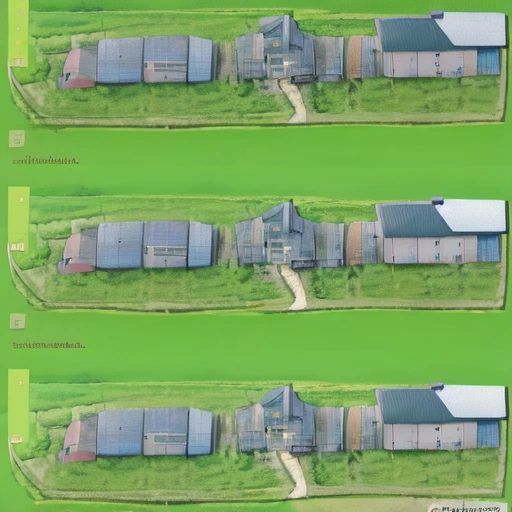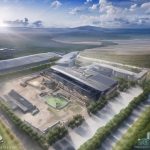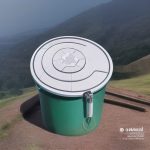Comprehensive Remote Property Infrastructure Planning Guide
Embracing the Off-Grid Dream: A Call for Comprehensive Planning
The allure of remote properties – secluded mountain cabins nestled in the Appalachians, expansive desert homesteads shimmering under the Arizona sun, or serene lakeside retreats reflecting the forests of Maine – is undeniable. They promise escape from the relentless pace of modern life, a deep sense of self-sufficiency, and an intimate connection with the natural world. However, realizing this dream of off-grid living requires meticulous planning, particularly when it comes to infrastructure. Unlike urban or suburban settings, remote properties often lack access to essential utilities like electricity sourced from the grid, municipal water supplies, and centralized sewage systems.
This necessitates a comprehensive and forward-thinking approach to infrastructure planning, one that considers everything from sustainable energy generation and responsible water management to efficient waste disposal and reliable communication networks. This guide provides a roadmap for navigating the complexities of remote property infrastructure, ensuring a sustainable, comfortable, and truly independent off-grid lifestyle. Embarking on remote property development demands a paradigm shift in how we perceive essential services. In conventional settings, we take for granted the seamless delivery of electricity at the flick of a switch.
However, on a remote property, generating your own power, often through solar power or other alternative energy sources, becomes a central challenge. Similarly, accessing potable water may involve drilling a well and implementing robust filtration systems, while waste management could necessitate exploring composting toilets and greywater recycling to minimize environmental impact. These self-sufficiency measures are not merely cost-saving strategies; they represent a commitment to sustainable infrastructure and responsible stewardship of the land, core tenets of the off-grid living philosophy.
Careful consideration of these factors upfront is essential for long-term success. The concept of sustainable infrastructure extends beyond simply providing basic amenities; it encompasses minimizing environmental impact and maximizing resource efficiency. For instance, passive solar design can significantly reduce heating and cooling loads, decreasing reliance on energy-intensive systems. Implementing rainwater harvesting not only conserves water but also reduces the strain on groundwater resources. Furthermore, choosing durable, locally sourced materials for construction minimizes transportation costs and supports local economies.
By embracing these principles, remote property owners can create self-sufficient homesteading environments that are both comfortable and environmentally responsible, demonstrating a commitment to sustainable development. Prioritizing these elements ensures that the pursuit of off-grid living aligns with the broader goals of environmental conservation and resource management. Ultimately, successful remote property infrastructure planning is about more than just technical solutions; it’s about fostering a deep understanding of the land and its resources. Conducting thorough site assessments, including soil testing, water table analysis, and solar irradiance studies, is crucial for making informed decisions. Engaging with local experts, such as well drillers, solar installers, and septic system specialists, can provide invaluable insights and guidance. Moreover, staying informed about relevant regulations and permitting requirements is essential for ensuring compliance and avoiding costly delays. By combining careful planning with local knowledge and a commitment to sustainability, remote property owners can create thriving off-grid environments that are both self-sufficient and environmentally responsible, realizing the full potential of their remote property investment.
Powering Independence: Energy Generation and Management
The cornerstone of any remote property, and perhaps the most critical element for achieving true off-grid living, is a reliable and sustainable energy source. Solar power is frequently the most economically viable and environmentally sound option for remote locations, but its effective implementation demands meticulous planning and a comprehensive understanding of energy needs. This begins with a detailed assessment of energy consumption, meticulously calculating the wattage requirements of all appliances, lighting fixtures, water pumps, and any other electrical devices that will be used regularly or intermittently.
For instance, a family homesteading in a remote area of Montana might require a larger solar array and battery bank than a solitary cabin dweller in the Arizona desert due to differences in heating needs and water usage. Careful consideration of seasonal variations in energy demand is also crucial, particularly in regions with cold winters or extended periods of cloud cover. This detailed energy audit forms the foundation for selecting the appropriate solar panel size, battery storage capacity, and inverter, ensuring the system can meet peak demands while optimizing energy efficiency.
While solar power often takes center stage, integrating alternative energy sources can significantly enhance reliability and resilience, creating a more robust and self-sufficient energy ecosystem. Wind power, particularly in areas with consistent wind patterns, can effectively supplement solar energy generation, especially during periods of low sunlight. Micro-hydro systems, harnessing the power of small streams or rivers, offer another viable option in suitable terrains, providing a continuous and predictable energy source. A hybrid system, combining solar, wind, and micro-hydro, offers redundancy and adaptability, ensuring a constant power supply regardless of weather conditions.
For example, a remote property in the Pacific Northwest might leverage solar panels during the sunnier months and a micro-hydro system fed by a mountain stream during the rainy season, creating a balanced and dependable energy portfolio. Backup generators remain an essential component of any well-designed off-grid power system, providing a safety net during extended periods of low sunlight, equipment maintenance, or unexpectedly high energy demand. Selecting the appropriate generator size and fuel type is crucial, balancing cost, efficiency, and environmental impact.
Propane generators are a popular choice due to their relatively clean burning and ease of storage, while diesel generators offer higher power output and fuel efficiency but come with increased emissions. Furthermore, advanced energy management systems are increasingly vital for optimizing energy usage and extending battery life. These systems, incorporating smart meters, automated load control, and sophisticated monitoring software, allow property owners to track energy consumption in real-time, identify areas for improvement, and prioritize critical loads during periods of limited power availability.
Such systems can automatically shed non-essential loads, such as electric water heaters or pool pumps, ensuring that essential appliances like refrigerators and lighting remain operational. Designing a complete solar power system for remote properties, especially those at high altitudes or in extreme climates, requires a detailed technical analysis that goes beyond simple estimations. Factors such as panel tilt angle, shading analysis, and temperature coefficients must be carefully considered to optimize energy capture and system performance.
The impact of snow accumulation on solar panel efficiency, for example, can be significant in mountainous regions, necessitating specialized mounting systems and snow removal strategies. Battery storage calculations must account for depth of discharge, temperature effects, and cycle life to ensure long-term reliability and prevent premature battery failure. Moreover, compliance with local regulations and permitting requirements is essential, as many jurisdictions have specific codes and standards for off-grid power systems. Engaging with experienced solar installers and energy consultants can help navigate these complexities and ensure a safe, efficient, and sustainable energy solution tailored to the unique needs of the remote property.
Water, Water Everywhere: Sourcing and Managing Water Resources
Access to clean and reliable water is paramount for any remote property, representing a critical element of self-sufficiency and sustainable off-grid living. Unlike urban environments with municipal water supplies, remote homesteads often rely on wells, springs, or rainwater harvesting, demanding a comprehensive understanding of water sourcing and management. Well systems, for instance, necessitate careful planning, including professional assessments of water table depth and yield, selection of appropriate submersible or jet pumps powered perhaps by solar energy, and rigorous, ongoing water quality testing to detect contaminants like bacteria, nitrates, or heavy metals.
Ignoring these factors can lead to water scarcity or health risks, undermining the entire premise of independent living. Rainwater harvesting, another popular option, involves capturing rainwater from rooftops using gutters and downspouts, directing it into storage tanks. The size of these tanks must be calculated based on local rainfall patterns and anticipated water usage, ensuring a buffer against drought periods. Filtration systems are not optional but essential components of any remote water system, regardless of the source.
These systems remove sediment, bacteria, viruses, and other contaminants to ensure water potability and protect the health of residents. Options range from simple sediment filters to more advanced systems incorporating UV sterilization, reverse osmosis, or activated carbon filters. The choice depends on the specific contaminants present in the water source and the desired level of purification. For example, a spring-fed system might benefit from a UV sterilizer to eliminate bacteria, while a well in an area with high mineral content might require a reverse osmosis system.
Regular maintenance, including filter replacement and system cleaning, is crucial to maintain optimal performance and prevent contamination. Greywater recycling systems offer a further layer of water conservation, aligning with sustainable infrastructure principles. These systems capture relatively clean wastewater from showers, sinks, and washing machines, treating it to remove contaminants, and then reusing it for non-potable purposes such as irrigation or toilet flushing. This reduces the demand on primary water sources, extending their lifespan and minimizing environmental impact.
The complexity of greywater systems can vary, from simple DIY setups using gravel filters to more sophisticated commercial systems with multi-stage filtration and disinfection. However, careful planning and adherence to local regulations are essential to prevent health risks and ensure proper functioning. Integrating a greywater system into a remote property’s infrastructure demonstrates a commitment to responsible water management and resource conservation, key tenets of self-sufficiency and off-grid living. Modern rainwater harvesting systems for off-grid properties demand a technical examination of collection methods, filtration systems, and storage solutions.
Gutters must be properly sized and maintained to efficiently channel rainwater, preventing overflows and potential damage to the property. First-flush diverters are essential to discard the initial rainwater runoff, which often contains the highest concentration of contaminants. Storage tanks should be made of food-grade materials and properly sealed to prevent contamination and algae growth. Regular cleaning and disinfection of the tanks are also crucial. Documenting water quality management, pressure systems, and integration with home plumbing is paramount for long-term sustainability. Detailed equipment comparisons and installation procedures should be readily available for maintenance and troubleshooting. Gravity-fed systems offer a low-energy alternative for water distribution, while pressure tanks and pumps may be necessary for larger properties or those with significant elevation changes. The selection of appropriate components and installation techniques is critical for ensuring a reliable and efficient water supply.
Waste Not, Want Not: Sustainable Waste Management Solutions
Managing waste responsibly is crucial for environmental sustainability. Traditional septic systems, relying on soil percolation, may not be suitable for all remote properties, particularly those with limited space, challenging soil conditions, or sensitive ecosystems near waterways. The expense of installing and maintaining a conventional septic system in a remote location, including potential environmental remediation costs if the system fails, can be prohibitive. Composting toilets offer an eco-friendly alternative, drastically reducing water consumption – a significant advantage in water-scarce regions – and producing valuable compost for enriching gardens and landscaping.
The humus created is not suitable for direct application to food crops but serves as an excellent soil amendment for ornamentals and trees. Greywater treatment systems can further reduce the burden on septic systems by treating wastewater from showers, sinks, and laundry, diverting it for subsurface irrigation of non-edible plants. Proper waste disposal practices, including rigorous recycling and composting of food scraps, are essential to minimize environmental impact and promote a closed-loop system. Off-grid waste management systems require modern solutions tailored to the unique challenges of remote living.
Selecting the right composting toilet system involves careful consideration of factors such as usage frequency, climate, and desired compost output. Options range from self-contained units ideal for occasional use to larger, centralized systems capable of handling waste from multiple dwellings. Advanced composting toilets often incorporate features like automated mixing and ventilation to accelerate decomposition and minimize odors. Greywater treatment options vary in complexity, from simple constructed wetlands to sophisticated mechanical filtration systems. Biological waste processing methods, such as vermicomposting (using worms to break down organic waste), offer another sustainable solution, especially in areas with limited space.
Understanding the specific needs of the remote property and the available resources is crucial for choosing the most appropriate waste management technologies. Installation requirements, maintenance procedures, and regulatory compliance considerations must be addressed proactively. Many jurisdictions have specific regulations regarding composting toilets and greywater systems, including permitting requirements and standards for effluent quality. Advanced greywater recycling systems require a technical understanding of water reuse systems, including filtration methods (such as sand filters or membrane bioreactors), distribution networks, and landscape integration.
For example, a remote homestead in Arizona might utilize a multi-stage greywater system, incorporating a settling tank, a constructed wetland with native plants, and a drip irrigation system for drought-tolerant landscaping. Regular monitoring of water quality and system performance is essential to ensure compliance and prevent environmental contamination. Furthermore, detailed documentation of system maintenance, including filter replacements and tank cleanings, is crucial for long-term sustainability and regulatory compliance. By embracing innovative and responsible waste management practices, remote property owners can minimize their environmental footprint and create a truly sustainable off-grid lifestyle.
Connecting the Dots: Communication, Security, and Accessibility
Beyond the core utilities of power, water, and waste management, a comprehensive infrastructure plan for remote properties must address communication, security, and accessibility. While the dream of off-grid living often conjures images of tranquil isolation, reliable communication links are crucial for both practical and safety reasons. Satellite internet offers a lifeline to the outside world in areas where traditional broadband is unavailable, enabling remote work, access to information, and vital connection with family and friends.
However, it’s essential to research providers and service plans carefully, considering factors like data caps, latency, and weather-related disruptions. For instance, Starlink, with its growing constellation of low-Earth orbit satellites, has emerged as a viable option for many remote locations, offering faster speeds and lower latency than traditional geostationary satellite services. Radio systems, particularly those utilizing VHF or UHF frequencies, provide a robust backup communication channel, especially valuable in emergencies when internet connectivity may be compromised.
Investing in a quality two-way radio system and establishing communication protocols with nearby homesteads or emergency services can be a literal lifesaver. Security measures are paramount for protecting remote properties from theft, vandalism, and other threats. The isolation that defines off-grid living can also make properties vulnerable. A multi-layered security approach is often the most effective, combining physical deterrents with technological solutions. Surveillance cameras, particularly those powered by solar energy and equipped with motion detection, can provide real-time monitoring and record evidence of suspicious activity.
Alarm systems, connected to a monitoring service via satellite or cellular networks, can alert authorities in the event of a break-in. Strategically placed lighting, reinforced doors and windows, and a visible security presence can further deter potential intruders. Beyond technology, fostering relationships with neighbors and participating in local community watch programs can enhance security and create a sense of shared responsibility. Remember, securing a remote property is not just about protecting assets; it’s about ensuring peace of mind and safeguarding a chosen way of life.
Accessibility, often overlooked in the initial excitement of acquiring a remote property, is a critical infrastructure component. Proper road access is essential for transporting building materials, equipment, and supplies, as well as for emergency vehicle access. Evaluate existing roads carefully, considering factors like grade, surface condition, and seasonal weather impacts. Investing in road improvements, such as grading, graveling, or culvert installation, may be necessary to ensure reliable access year-round. For properties located in mountainous or heavily forested areas, consider the need for snow removal equipment or all-terrain vehicles. Furthermore, site selection for remote properties demands a strategic analysis framework. This includes a detailed methodology for evaluating potential off-grid locations, encompassing water access assessment, solar exposure calculation, and soil quality testing. Legal considerations, zoning requirements, and accessibility planning are also important. Remote communication systems require a technical evaluation of satellite internet options, radio systems, and emergency communication equipment. Coverage analysis, equipment recommendations, and backup system planning are essential for self-sufficiency and safety.


